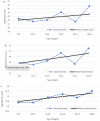Age-Related Variance in Performance versus Ratings of Attention and Impulse Regulation in Children: Implications for the Assessment of ADHD
- PMID: 36009096
- PMCID: PMC9406227
- DOI: 10.3390/brainsci12081033
Age-Related Variance in Performance versus Ratings of Attention and Impulse Regulation in Children: Implications for the Assessment of ADHD
Abstract
Executive function task (EF) deficits are hypothesized to underlie difficulties with self-regulation. However, tasks assessing EF impairments have only been weakly correlated with rating scales that index self-regulation difficulties. A community sample of children and youth aged between 8 and 20 years old were assessed longitudinally. Growth curve analyses and correlations were conducted to better understand how these two types of measures relate to one another across development, as well as the impact of age-related variance. EF was assessed using the Stroop Task and Trail Making test and behavioral ratings of self-regulation were captured using the SWAN scale. EF task performance improved steeply until age 14-15, whereas the SWAN Scale showed small age-related decreases. EF task performance was moderately correlated with age among 8-13-year-olds and to a lesser extent among 14-20-year-olds. SWAN scores were not significantly related to age in either group. Correlations were similar in an ADHD "at-risk" subgroup. EF task performance and parent ratings of attention regulation have different developmental trajectories, which may partly explain why correlations are low to modest in these samples. In particular, age-related variance is an important methodological consideration with significant implications for the assessment of self-regulation in children and youth with ADHD.
Keywords: attention-deficit hyperactivity disorder (ADHD); behavior ratings; executive function; longitudinal; self-regulation; strengths and weaknesses of ADHD symptoms and normal behaviors rating scale (SWAN).
Conflict of interest statement
The authors declare no conflict of interest.
Figures




Similar articles
-
Common mechanisms of executive attention underlie executive function and effortful control in children.Dev Sci. 2020 May;23(3):e12918. doi: 10.1111/desc.12918. Epub 2019 Nov 26. Dev Sci. 2020. PMID: 31680377
-
Parent-reported executive function behaviors and clinician ratings of attention-deficit/hyperactivity disorder symptoms in children treated with lisdexamfetamine dimesylate.J Child Adolesc Psychopharmacol. 2013 Feb;23(1):28-35. doi: 10.1089/cap.2011.0120. J Child Adolesc Psychopharmacol. 2013. PMID: 23410139 Clinical Trial.
-
Executive function assessment and adult attention-deficit/hyperactivity disorder: tasks versus ratings on the Barkley deficits in executive functioning scale.Psychol Assess. 2014 Dec;26(4):1095-105. doi: 10.1037/pas0000006. Epub 2014 Jun 2. Psychol Assess. 2014. PMID: 24885846
-
A Multi-Theoretical and Multi-Method Family Study Approach to Preschool Inhibitory Control: Links to Working Memory, Receptive Vocabulary, Behavioral Maladjustment, and Parent Mental Health in the Context of Temperament and Executive Functioning Perspectives.Front Psychol. 2021 Aug 12;12:703606. doi: 10.3389/fpsyg.2021.703606. eCollection 2021. Front Psychol. 2021. PMID: 34475839 Free PMC article.
-
The Three-year Outcome of Emotional Symptoms in Clinically Referred Youth with ADHD and their Relationship to Neuropsychological Functions.Scand J Child Adolesc Psychiatr Psychol. 2022 Jul 3;10(1):72-86. doi: 10.2478/sjcapp-2022-0008. eCollection 2022 Jan. Scand J Child Adolesc Psychiatr Psychol. 2022. PMID: 35903554 Free PMC article.
References
-
- Nigg J.T. Annual research review: On the relations among self-regulation, self-control, executive functioning, effortful control, cognitive control, impulsivity, risk-taking, and inhibition for developmental psychopathology. J. Child Psychol. Psychiatry. 2017;58:361–383. doi: 10.1111/jcpp.12675. - DOI - PMC - PubMed
Grants and funding
LinkOut - more resources
Full Text Sources

